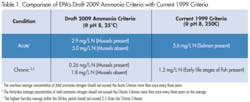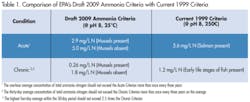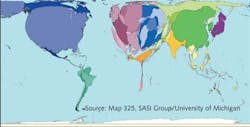By Dave Clark
Wastewater managers face an increasing array of regulatory requirements stemming from the Clean Water Act. Increased emphasis on compliance accountability and enforcement has escalated scrutiny of monitoring, operations, and facility performance. Regulatory requirements for wastewater treatment continue to evolve with increasing emphasis on nutrient control, potentially more restrictive federal ammonia criteria, and calls for development of water quality criteria for endocrine disrupting chemicals.
Excessive nitrogen and phosphorus loadings to watersheds impact water quality by stimulating the growth of algae which may result in depletion of dissolved oxygen, shifts in pH, degradation of habitat, impairment of drinking water sources, and in some cases harmful algal blooms. According to the EPA, nearly every state has nutrient related pollution with impacts in over 80 estuaries/bays, and thousands of rivers, streams, and lakes. The national discussion of nutrient impacts on water quality continues to evolve with high visibility water bodies such as the Chesapeake Bay, Long Island Sound, Gulf of Mexico, and Puget Sound receiving attention.
Development of nutrient standards is underway in several key states. Bridging the gap between what may be required by in-stream nutrient criteria and the capabilities of wastewater treatment technology is an issue arising in the standards development process. A variety of approaches are being considered, including compliance schedules, site specific criteria, water quality variances, and a new approach introduced by EPA in Florida called restoration standards.
Florida
On January 26, 2010, EPA proposed water quality criteria for lakes and flowing waters in the state of Florida. The proposed nutrient standards became final on Nov. 14, 2010, for four water body types: lakes, streams, springs and clear streams, and canals in south Florida. Implementation of numeric nutrient criteria for lakes and flowing waters will not take effect for 15 months to allow EPA, the state and stakeholders to prepare for implementation.
EPA's proposed Florida nutrient criteria included a section called "Alternative Regulatory Approaches and Implementation Mechanisms" that presents a discussion of several tools for implementing nutrient control requirements. A procedure for deriving federal site-specific alternative criteria (SSACs) was included to account for where site-specific data suggests the need for refinements to the federal criteria. EPA also introduced a new tool called Restoration Standards, which appears similar in some characteristics to a water quality variance in that full compliance can be extended by phasing for eventual attainment of water quality standards. EPA has framed Restoration Standards to consider a broad range of watershed management issues, including nonpoint source controls, and innovative and flexible approaches.
EPA's original proposal included nutrient criteria for both in-stream protection values, as well as downstream protection values for lakes and estuaries. Downstream protection values were deferred to allow for review by EPA's Science Advisory Board. EPA plans to publish proposed nutrient criteria for estuaries and coastal waters by November 2011 and finalize the criteria by August 2012.
Colorado
In 2002, the Colorado Department of Public Health and Environment (CDPHE) initiated a nutrient criteria development plan and chose not to adopt EPA ecoregion reference criteria in the interest of developing more site-specific standards. In February 2010, CDPHE proposed nutrient criteria for rivers and streams based on aquatic life use protection criteria with a stressor-response relationship linking nutrient concentrations with Colorado's macroinvertebrate multi-metric indices (MMIs).
Colorado's acute and chronic standards include the concept of protecting 95 percent of the genera from acute or chronic effects of the parameter. This concept is included in the CDPHE proposal for numeric nutrient standards to select criteria that allow a 5 percent decrease in biological conditions based on an Observable Biological Potential ("OBP") that describes the decline in biological condition as a function of increasing nutrient concentrations. The nutrient criterion is to be determined by locating the concentration at which the OBP is expected to be 5 percent below the reference condition, with the anchor point for the allowable decline set at the 85th percentile concentration of the set of reference sites.
Colorado appears to have made significant progress since in developing nutrient criteria and is working toward integrating those criteria into their water quality standards. The Colorado Water Quality Control Commission has decided to delay consideration of numeric nutrient criteria for rivers and stream, lakes and reservoirs, and direct-use water supply reservoirs until June 2011.
Colorado's Nutrient Criteria Work Group is considering a variety of options for adopting and implementing nutrient standards, including adoption of numeric nutrient criteria as "interim standards" for water bodies in each of Colorado's seven major river basins with table values for nutrients (total phosphorus and total nitrogen, with a delayed effective date for nitrogen), indicators (chlorophyll a for lakes and reservoirs), and adoption of a control regulation. The control regulation would require significant point source discharges of nutrients either to meet specified effluent limitations through biological nutrient removal or reduce nutrient discharge concentrations through implementation of appropriate best management practices.
Wisconsin
In late 2009, a coalition of environmental groups announced their intent to sue EPA to promulgate numeric nutrient criteria for phosphorus and nitrogen for the State of Wisconsin. The State developed water quality criteria for phosphorus and the Department of Natural Resources formed a technical advisory committee to assist with development of criteria and to review draft rules for nutrient standards. The phosphorus criteria developed for streams is 0.075 mg/L and for large rivers is 0.100 mg/L. The phosphorus criteria developed for lakes and reservoirs varies from 0.015 mg/L to 0.40 mg/L depending upon stratification and drainage characteristics. The criteria are based on studies completed on Wisconsin waterbodies, along with scientific concepts for river and lake water quality. While Wisconsin does not have nitrogen on the priority list, nitrogen is also expected to require examination in the future.
Montana
The State of Montana began developing numeric nutrient criteria in the early 2000s. Montana's approach has included review of reference stream criteria, scientific studies to develop a technical basis for wadeable streams criteria, site specific investigations of some larger key rivers, and a public survey of perceptions of stream health and bottom algae where respondents viewed photographs to determine whether the conditions were desirable or undesirable. Based on these studies, the Montana Department of Environmental Quality planned to initiate a rule-making phase for state adoption of numeric nutrient standards in 2010.
Montana developed water quality variance legislation anticipating adoption of numeric nutrient standards would result in conditions that would be to expensive or infeasible from the standpoint of wastewater treatment technology. Montana Senate Bill 95 provides for temporary nutrient criteria to establish permit limits for point source discharges to surface water and became law in 2009 (MCA 75-5-313). On a case-by-case basis, Montana DEQ may approve the use of temporary nutrient criteria if the attainment of the base numeric nutrient standards is precluded due to economic impacts, or the limits of treatment technology.
Ammonia Nitrogen
EPA has recently published revised federal ammonia criteria for public comment that may result in more restrictive effluent limits for many wastewater dischargers if implemented by states as standards. The comment period for EPA's "Draft 2009 Update Aquatic Life Ambient Water Quality Criteria for Ammonia - Freshwater" ended on April 1, 2010. The revised criteria are significant because they reflect the greater sensitivity of freshwater mussels to potential toxic effects of ammonia than other aquatic organisms and may result in more restrictive effluent discharge limits. EPA is not revising water quality criteria for ammonia in saltwater.
The acute and chronic ammonia criteria vary with temperature and pH and Table 1 presents a summary comparison of the Draft 2009 criteria with the current 1999 criteria at a pH 8 and temperature of 25 degrees C. The Draft 2009 acute criteria are lower than the current criteria when freshwater mussels are present. For the chronic criteria, which is the controlling condition for many discharge permits, the Draft 2009 criteria are much lower than existing when mussels are present.
States must adopt water quality criteria that protect designated uses that may be based on EPA's recommended water quality criteria or other scientifically defensible methods. Wastewater dischargers can review the potential impact of the Draft 2009 ammonia criteria on their future effluent discharge limits by repeating the reasonable potential calculations in their last discharge permit using EPA's newly proposed criteria. The key determination is whether or not mussels are present. This may be a difficult question to answer given current information.
According to EPA, many states have freshwater mussels in at least some of their waters. Further, approximately one-quarter of freshwater unionid mussel species are Federally listed as endangered, threatened, or are of special concern. However, there is no readily available resource to identify the presence of freshwater mussels or their habitat.
EPA had hoped to publish final ammonia criteria in late 2010, along with a draft of implementation guidance to clarify how the criteria are to be interpreted.
Priority Pollutants
Beyond current requirements to reduce nutrient loadings and control potential ammonia toxicity, wastewater utilities face increasing scrutiny of surface water discharges for compounds that are not commonly the basis for municipal treatment process design. Interesting efforts are underway to monitor persistent priority pollutants and there are calls for water quality criteria to be developed for endocrine disrupting chemicals.
EDCs are widespread environmental contaminants that have several classes and those EDCs that imitate estrogen are of specific concern. EDCs affect reproduction, fertility, and gonad morphological changes. EDCs may include pesticides, polychlorinated biphenyl (PCBs), solvents, metals, and pharmaceuticals and personal care products (PCPPs). Potential EDC sources are widespread and include agricultural and urban runoff, treated wastewater effluent discharges, legacy contamination, and other sources.
Oregon Senate Bill 737
In 2007 the Oregon legislature passed Senate Bill 737 that requires the Oregon Department of Environmental Quality to develop a list of priority persistent pollutants (P3 list) that could have effects on human health, wildlife, and aquatic life. The bill required the largest 52 municipal wastewater treatment facilities in Oregon to conduct two rounds of effluent monitoring for P3 compounds in 2010. For those compounds found to be above the "initiation level" concentrations established by Oregon DEQ, utilities are required to develop plans for reducing priority persistent pollutants through pollution prevention and toxics reduction by July 1, 2011.
The breadth and depth of municipal pollution prevention plans has yet to be defined. Contents of a plan are expected to include potential pollutant sources, programs for reduction, methods to estimate quantities generated, and estimates of pollutant reduction effectiveness.
The initial results from the first round of effluent discharge sampling in Oregon found that the nearly all of the dischargers exceeded the "initiation levels" for two compounds: cholesterol (sterol synthesized by animals) and coprostanol (sterol formed by conversion of cholesterol in the gut and a biomarker for the presence of fecal matter). It is unclear how these monitoring results will be reconciled with the requirements of SB737 to have pollution prevention plans adopted by July 1, 2011.
About the Author: Dave Clark, PE, is HDR's National Director of Wastewater. He is based in the engineering firm's Boise office.
Research Program Examines Nutrient Challenges
The Water Environment Research Foundation Nutrient Challenge is a multi-year collaborative research initiative established in 2007 to develop and provide current information about wastewater treatment nutrients (specifically nitrogen and phosphorus in wastewater), their characteristics, and bioavailability in aquatic environments to help regulators make informed decisions. Researchers also hope to develop data on nutrient removal performance to help treatment facility operators select sustainable, cost-effective methods and technologies to meet permit limits.
To meet these goals, the researchers have teamed with a wide array of utilities, agencies, consultants, universities and other researchers and practitioners to collaborate on projects that advance these goals. Using a strategic approach to leverage resources (financial and intellectual) on research projects, the nutrient challenge initiative is targeting existing projects and research that correspond with its goals and funding those aspects that are identified as a priority.
The nutrient challenge program is both presenting important new information and soliciting new partnerships through workshops, webinars, a web portal and online compendium, published papers, and conference lectures.
Challenge research is focused on five key areas, each interlinked and building upon the others:
- Regulatory issues
- Nitrogen research
- Phosphorus research
- Design and Modeling
- O&M
Current research efforts and key findings such as the Nutrient Management Compendium, an online resource that summarizes key regulatory and technological issues, are available at www.werf.org/nutrients.
One of the key WERF Nutrient Challenge studies currently underway is titled "Finding the Balance Between Wastewater Treatment Nutrient Removal and Sustainability, Considering Capital and Operating Costs, Energy, Air and Water Quality." This investigation will determine the cost and sustainability impacts at various levels of treatment. An important objective is to determine if there is a point of "diminishing returns" where the sustainability impacts of increased levels of nutrient removal outweigh the benefits of better water quality.
Case Study
The City of Coeur d'Alene has been an active collaborator with WERF on nutrient research by participating in research projects and contributing cost share funding. The city is currently preparing to expand and upgrade its wastewater treatment plant in response to growth and new, very stringent effluent phosphorus discharge criteria.
The Spokane River total maximum daily load (TMDL) requires an effluent limit as low as 36 mg TP/L in the summer months, along with equally challenging CBOD, and ammonia nitrogen limits. Meeting these challenges requires substantial investment in additional treatment capacity and technology at the Coeur d'Alene Wastewater Treatment Plant.
The water chemistry of both the wastewater influent and the Spokane River, specific to Coeur d'Alene, coupled with the Pacific Northwest climate greatly influences the appropriate selection of treatment processes to achieve extremely low effluent phosphorus concentrations. To aid in process selection and assist in the training of operations staff, the city is conducting a two year demonstration testing program that features the candidate treatment processes for low phosphorus effluent, building upon small scale pilot testing study conducted in 2006.
The Coeur d'Alene Low Phosphorus Pilot Facility began operating in April 2010. The pilot consists of three treatment technologies: a membrane bioreactor, tertiary membrane filtration with alum, and continuous upflow media filtration with iron-coated sand. Each technology experienced very encouraging results after the initial start-up with effluent phosphorus concentrations below 50 mg/L. Several equipment and start-up issues have been addressed during the initial operating period.
Effluent samples from the Coeur d'Alene Pilot will be included in WERF phosphorus speciation studies, as well as phosphorus bioassay studies being conducted at the University of Washington in a research project sponsored by the Washington Department of Ecology, WERF, and Spokane River Dischargers such as Coeur d'Alene, Spokane County, the City of Spokane, and others.
More WaterWorld Current Issue Articles
More WaterWorld Archives Issue Articles





